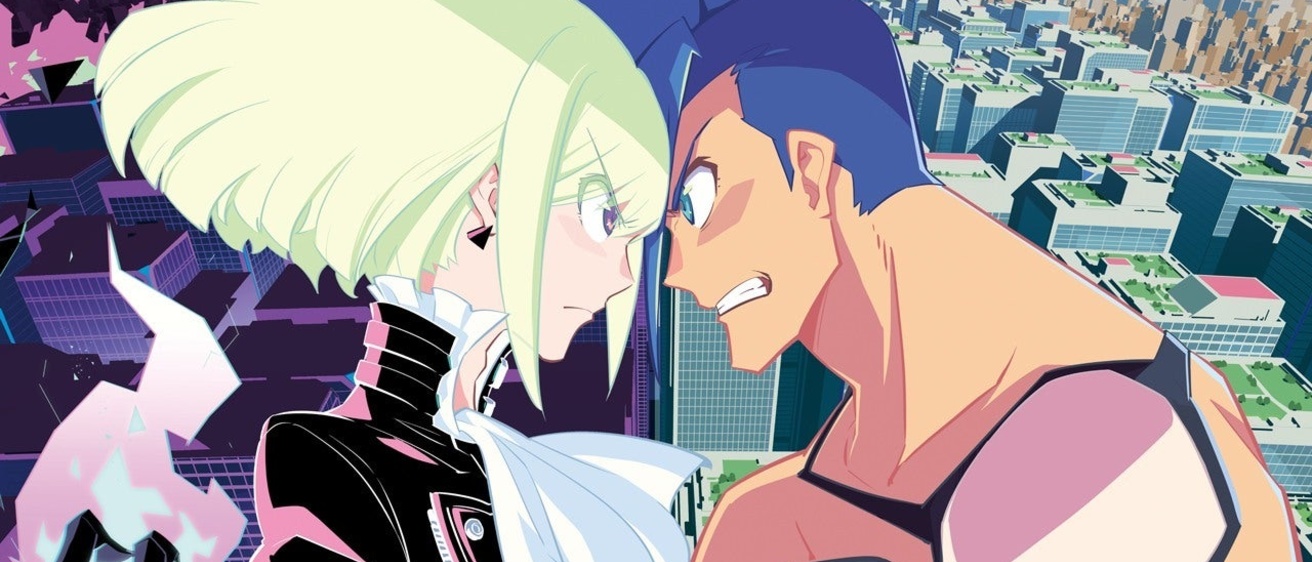By Gigi Bell
In one of the most striking scenes of Promare (2019), the first feature-length film from Japanese studio Trigger, the city of Promepolis is under attack. The city’s dull gray buildings, reduced to lifeless shapes under a moon-and-starless night, have suddenly erupted into eye-burning neon fire. This is no natural fire. Its flames crack and pop in bold pinks and greens, exploding into triangular shapes that threaten to slice the city’s perfect, orderly rectangles into pieces. As the night sky becomes lit by pink flame and purple plumes of smoke, the source of the destruction becomes apparent. A massive dragon weaves between the buildings. Its soft pink glow contrasts strongly with its aggressive behavior. This dragon is on fire too, or perhaps it is made from the flames itself. Every so often, it lets out an enraged roar and another row of buildings light up. The citizens of Promepolis are powerless to fight this threat. Their weapons are useless against these odd flames, this unknown dragon.
Little do they know, they have it all wrong. Only Galo Thymos (Kenichi Matsuyama), a firefighter, standing in bewilderment as the dragon roils through the air above him, knows the truth of this attack. His eyes alight in instant recognition. This dragon, this fire – he knows them. They are not the work of some otherworldly threat to the city, but rather the manifestations of Mad Burnish leader Lio Fotia (Taichi Saotome). Lio possesses a violent talent: the creation and control of fire that seems to twirl and twitch with a will of its own. Those with this ability have been named the Burnish, and many attempts have been made to smother their persistent embers over the years. The orderly Promepolis has no room for unpredictable flames. Tonight, however, Lio has decided that he’s had enough.
The next realization that Galo has might be the emotional heart of the film. Almost unnoticed among the chaos, he sees that tears are streaming from the dragon’s eyes, a contrail of sorrow that quickly turns to vapor among the heat of the flames. This act of destruction is not born of rage but born of grief. In the few days that Galo and Lio have known one another, Lio has maintained a cold, calculated exterior in spite of the heat of his flames and the battles he wields them in. However, like magma building up beneath the Earth’s surface, emotions can only build for so long before they must erupt.
Galo knows that Lio is no stranger to grief. Though the two men are rivals – Lio a Burnish creating fire, Galo a firefighter set on snuffing those flames out – each confrontation between them represents the building of a tentative emotional bond. When, in an earlier scene, Galo witnessed Lio try and fail to revive a dying Burnish girl, the flash of resigned despair in Lio’s eyes profoundly affected Galo, his usually confident, outspoken demeanor dimming somewhat in subsequent scenes. Galo feels Lio’s pain as his own. Though Lio is set on ravaging the city that Galo has sworn to protect, Galo still sees the tears in Lio’s eyes and knows that they key to ending the chaos is not through use of the city officials’ freezing weapons, but through conveying to Lio that he understands his pain, and that he is willing to help him through it.
As soon as Galo has this realization – a moment that lasts no more than a few seconds – Promare returns to its usual displays of bombast. Lio’s dragon destroying the city is only one instance of many bright neon spectacles that bounce around the screen during the film’s many fast-paced action set pieces. These spectacles have the cinematography of Shinsuke Ikeda to thank, as well as the art direction of Tomotaka Kubo, not to mention the host of animators who have also worked on Trigger’s past TV works such as Kill la Kill.
